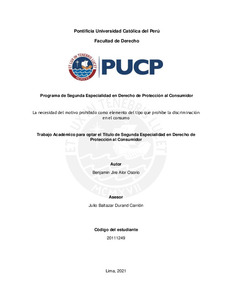| dc.contributor.advisor | Durand Carrión, Julio Baltazar | |
| dc.contributor.author | Alor Osorio, Benjamin Jire | |
| dc.date.accessioned | 2021-09-27T21:27:16Z | |
| dc.date.available | 2021-09-27T21:27:16Z | |
| dc.date.created | 2021 | |
| dc.date.issued | 2021-09-27 | |
| dc.identifier.uri | http://hdl.handle.net/20.500.12404/20457 | |
| dc.description.abstract | El objetivo general del trabajo es determinar si el tipo infractor de discriminación en el
consumo, contenido en el artículo 38º del Código de Protección y Defensa al Consumidor,
debería o no contemplar como uno de sus elementos constitutivos el motivo prohibido de
diferenciación, es decir, que el denunciante pertenezca a un grupo humano considerado
vulnerable y que expresa o implícitamente proteja el listado del numeral 2 del artículo 2º de
la constitución. Para este propósito, el autor ha revisado jurisprudencia constitucional y
administrativa relevante, así como el desarrollo que se ha hecho del concepto y sus funciones
en el orden convencional y en la doctrina. Así, luego de este desarrollo, son conclusiones del
presente trabajo que el concepto de discriminación en el consumo sí debe requerir como
elemento constitutivo la pertenencia del denunciante a un motivo prohibido de
diferenciación, pues dicha opción interpretativa es la más coherente con el marco
convencional y constitucional y la más congruente con la función que se ha pensado para
esta institución jurídica. | es_ES |
| dc.description.abstract | The main goal of this paper is to determine whether the type of consumer discrimination,
contained in the article 38º of the Código de Protección y Defensa al Consumidor, should
consider or not, as one of it constitutive elements, a prohibited motive of differentiation, that
is, requiring the complainant to belong to a human group considered vulnerable and expressly
or implicitly protected in the list of the 2.2 article of the Peruvian constitution. In order to
achieve this, the author has reviewed relevant constitutional an administrative jurisprudence,
as well as what has been said of the concept and its functions in the conventional order an in
the doctrine. Thus, the conclusions of this paper are that the consumer discrimination should
require, as a constitutive element, the belonging of the complainant to a prohibited motive of
differentiation, given that said option is the most consistent with the conventional and
constitutional framework and the most congruent with the mission that has been thought for
this legal institution. | es_ES |
| dc.language.iso | spa | es_ES |
| dc.publisher | Pontificia Universidad Católica del Perú | es_ES |
| dc.rights | info:eu-repo/semantics/openAccess | es_ES |
| dc.rights.uri | http://creativecommons.org/licenses/by/2.5/pe/ | * |
| dc.subject | Protección del consumidor--Perú | es_ES |
| dc.subject | Discriminación--Perú | es_ES |
| dc.title | La necesidad del motivo prohibido como elemento del tipo que prohíbe la discriminación en el consumo | es_ES |
| dc.type | info:eu-repo/semantics/bachelorThesis | es_ES |
| thesis.degree.name | Segunda Especialidad en Derecho de Protección al Consumidor | es_ES |
| thesis.degree.level | Título Profesional | es_ES |
| thesis.degree.grantor | Pontificia Universidad Católica del Perú. Facultad de Derecho | es_ES |
| thesis.degree.discipline | Derecho de Protección al Consumidor | es_ES |
| renati.advisor.dni | 06726360 | |
| renati.advisor.orcid | https://orcid.org/0000-0002-2926-1912 | es_ES |
| renati.author.dni | 71732249 | |
| renati.discipline | 421059 | es_ES |
| renati.level | https://purl.org/pe-repo/renati/level#tituloSegundaEspecialidad | es_ES |
| renati.type | https://purl.org/pe-repo/renati/type#trabajoAcademico | es_ES |
| dc.publisher.country | PE | es_ES |
| dc.subject.ocde | https://purl.org/pe-repo/ocde/ford#5.05.01 | es_ES |






